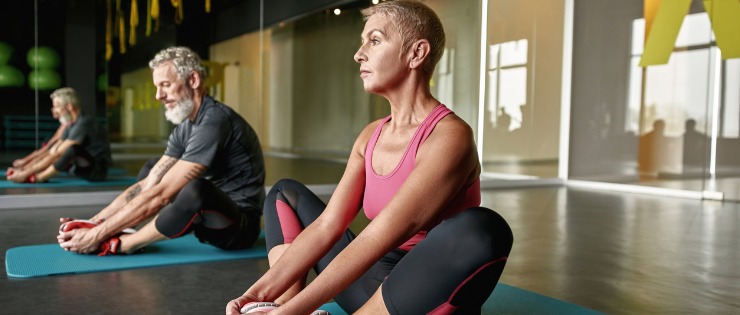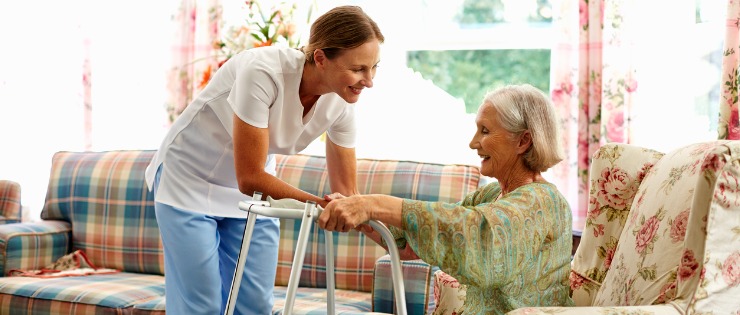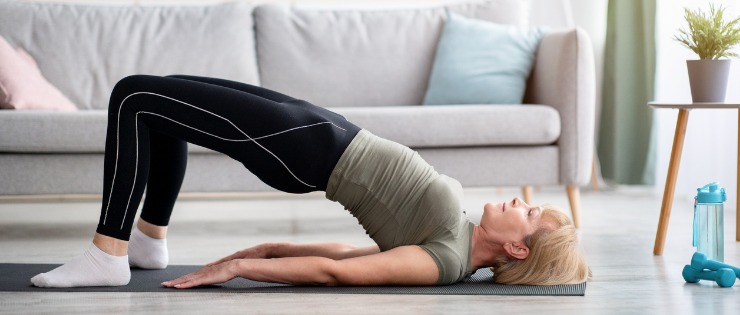Hip Strengthening Exercises to Try at Home
It’s important to stay safe while exercising. Use a chair or a sturdy object as a support. If you start to feel dizzy or off-balance, stop exercising and rest. Not all exercises are ideal for everyone. Before starting any new exercise program, check with your GP.
#1 Butterfly Pose
In a seated position, bring the soles of your feet together while sitting up straight and pulling in your abs. Grab hold of each foot with your hands and place elbows against your inner thighs. Inhale and as you exhale, slowly lower your torso forward and pause when you feel a stretch. Hold the stretch for 30 seconds.
The butterfly pose is an effective pose that targets:
Hip flexors
Entire hip complex
Inner and outer thighs
The benefits of holding the butterfly pose can include reducing hip pain caused by tight hip muscles and relieving lower back pain.

#2 Hip Abduction Exercise
Stand upright and place your hands on the back of a chair. Slowly raise one leg off the ground and hold for three seconds before returning to the centre. Repeat five times before switching legs.
This hip abduction exercise targets your abductor muscles and is ideal for anyone who finds it difficult to get up and down from the ground. This exercise requires you to use a chair as a support while you do the exercise standing up. The hip abductor muscles help with stability while walking and standing on one leg.
#3 Standing Hip Flexor Exercise
With your feet standing apart and both hands on your hip, step your foot forward. Slowly bend your left knee while lifting your right heel off the ground. Lean forward while squeezing your right glute and hold for 30 seconds. Return to the standing position and repeat with the other leg.
This standing hip flexor exercise targets your front hip flexors, helping to build hip flexor strength and reducing back pain.

#4 Prone Straight Leg Raise
Lie faced down on a mat while sucking in your core muscles. Slowly lift one leg up while keeping your stomach on the mat and squeezing your glute muscles. Hold for 3 seconds before lowering your leg. Repeat several times before swapping to the other leg.
This prone straight leg raise targets your hip flexor and is a common exercise for post-hip surgery patients as it helps to relieve hip pain.
#5 Hip Raises
While lying on your side on your mat, raise your top leg then slowly bring it down to meet the other leg for a count of 5. Repeat five times. Roll on to your other side and repeat raising the other leg.
Hip raises target your obliques and help to stabilise the pelvis and lower back.
#6 Hip Marches
This is an ideal exercise for any seniors who are concerned about exercising on their feet for fear of a fall. Sit on a chair with your feet flat on the floor. Keep your back against the chair and maintain proper posture. Lift one knee as high as is comfortable then lower it. Repeat 10 times then swap and lift the other knee. Repeat 10-15 times on each side.
Hip marches target your glutes and hamstring muscles, helping to increase core stability and enhance the ability to walk, as well as aiding to relieve hip and knee pain.

#7 Bridges
Lie on your back with your knees bent and feet flat on the ground. Squeeze the glute muscles and lift your hips up without arching your back. Hold for three seconds at the top then lower the hips back down. Repeat 10 times.
Bridges target your glute muscles and help to build strength for walking, standing from seated position and climbing stairs.
#8 Clamshells
Place a resistance band around both thighs. Lie on your back with your knees bent and feet flat on the ground. Push your knees out to the side against the band, hold for three seconds and then bring your knees back together. Repeat 10 times.
Clamshells also target your glute muscles, providing support for the pelvis and improving standing balance.
#9 Sit-to-Stand
Sit in a chair with a medium to hard seat. Lean your body forward then push yourself up from the chair, trying not to use your hands to help you push up from the seat. Once fully extended, squeeze your glutes. Push your hips back slowly and lower yourself back on to the chair gently. Repeat 10 times.
This sit-to-stand exercise targets the glute muscles, working to strengthen your glutes and core muscles. This helps with standing up from the seated position and getting out of the car.
Expert Advice for Your Hips
Through our partnership with Kieser centres, eligible HIF members with Hospital cover can now access Kieser's hip osteoarthritis program, knee osteoarthritis program and spinal program with the costs covered. Other services provided at Kieser centres, outside of the programs listed, may be covered under your normal extras policy. For full eligibility criteria please visit our Kieser webpage.